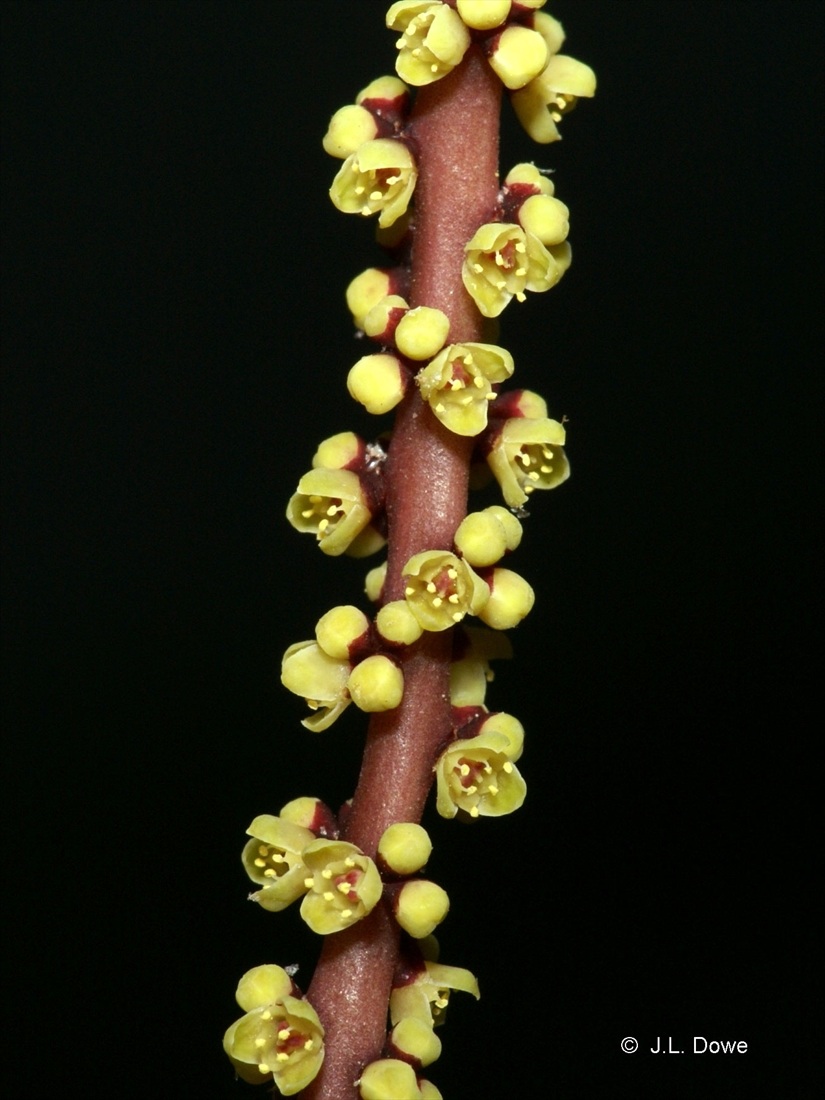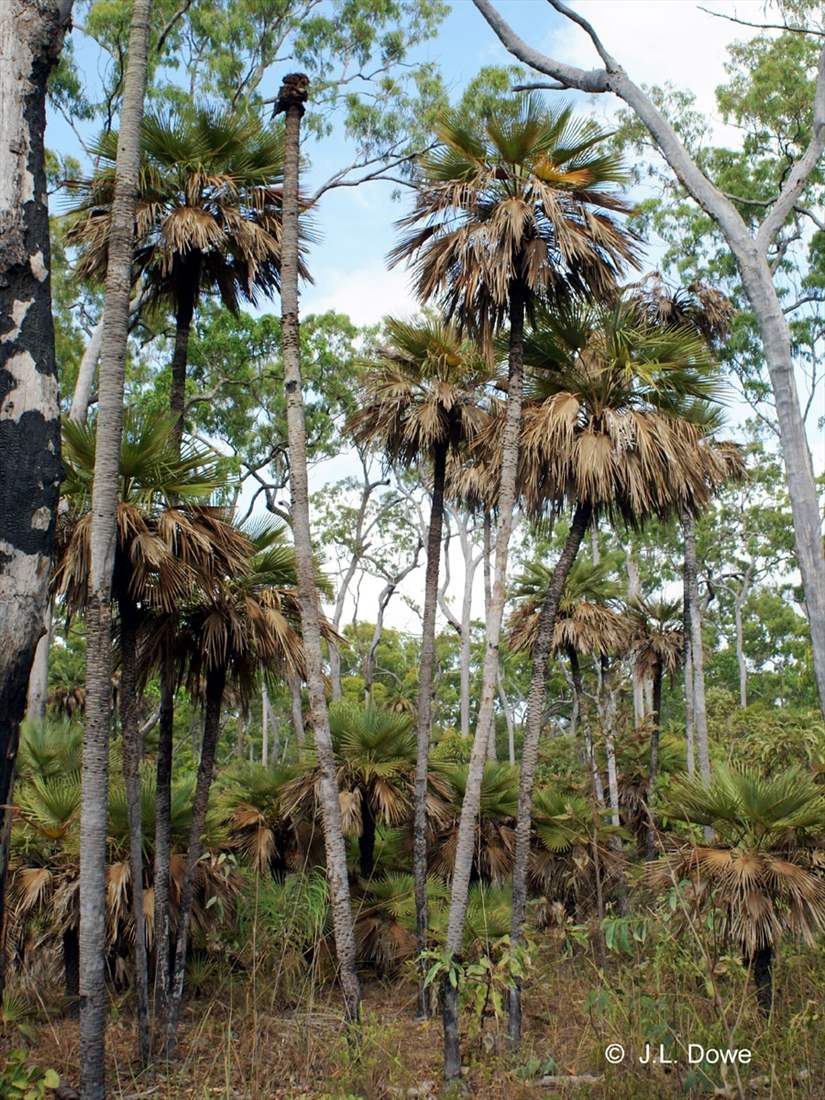Australian Tropical Rainforest Plants - Online edition
Livistona muelleri F.M.Bailey





Bailey, F.M. (1902) The Queensland Flora 5: 1683. Type: Cairns, E. Cowley.
Northern Cabbage Palm
Trunk solitary, up to 10 m tall and 15-20 cm diameter at 1 m above ground, often broadening gently but shortly at base into a cone up to 30 cm diameter on a pedestal of roots of still larger diameter. Surface closely ringed with sheath scars; vertical fissures prominent, some long and deep, others short and very shallow; basal 2 m or so clothed in persistent, semi-appressed petiole-stubs often more than 10 cm long. Plants functionally male or female.
Crown ± globose, consisting of ca. 25-35 stiffly radiating leaves, most spreading at slightly above or slightly below horizontal. Ligules straw-coloured to pale brown, outer surface sparsely to densely dotted with thick, corky scales in pits, their surfaces flush with ligule surface. Petiole 70-100 cm long, 14-19 mm wide; concave-convex to flattened-triangular in cross-section. Margins with minute dark red-brown linear calli; shiny blackish, pungent prickles to c. 4 mm long towards base; much shorter or sometimes absent on apical half. Surfaces green, undulately striate, the upper with numerous linear pits to 7 mm long containing conspicuous rows of thick, corky, persistent red-brown scales (soon fading to grey). Hastula base truncate to rounded; rim at 10-60° to costa,8-20 mm wide, the necrotic margin narrow to very broad and irregularly disintegrating. Lamina 70-80(-90) cm long, weakly costapalmate, ± circular with narrow sinus at base, chartaceous, brittle and readily splitting, to coriaceous and moderately tough; flat or slightly contorted. Segments 28-30 either side of costa; largest segments 25-32 mm wide, widest at base, free for 50-65% of their length, bifurcated for 5-14% of free length, the lobes parallel, shortly acute or (occasionally) abruptly curved outward, or more commonly tapering evenly to a fine bristle-like point. Intersegmental appendages delicate, brittle, threadlike, to 7 mm long, mostly absent from fully expanded leaves. Major longitudinal veins 8-9 either side of midrib, prominent above, slightly less prominent beneath; transverse veins moderately prominent to somewhat obscure above, more prominent beneath. Surfaces shiny olive green to somewhat grey-green above, below dull bluish-green with densely crowded stomates and slightly to moderately glaucous with thin, delicate waxy bloom, glabrous except for scurfy scales along angles of ribs toward base.
Inflorescences slightly shorter than leaves, sometimes much shorter, fairly stiff and strongly ascending, somewhat pyramidal in form with stiffly spreading branches. Partial inflorescences 5-10, reducing markedly in size toward inflorescence apex, the lowest mostly exceeding 12 of total inflorescence length; rachillae 1.5-13 cm long, 0.5-1.0 mm diameter, these and other axes pinkish-brown to dark red-brown, the surfaces wrinkled-striate and minutely granular-papillose giving a slight ‘frosted’ appearance. Rachis bracts smoothly flattened-cylindrical, to c. 25 mm diameter, tightly sheathing to somewhat undulately distorted or torn, dark red-brown, greying with age; surfaces closely striate with raised veins, sparsely to densely flecked with pale straw-coloured to silvery appressed scales; bract apices narrowly ovate-triangular, mostly ± cuspidate with necrotic tip, often with dense fringe of whitish scales along part of margin. Flower-clusters 1-3 mm apart, 1-3-flowered; cluster axis present only as a slight steplike protrusion on rachilla, to 0.5 mm long at anthesis, enlarging in fruit to up to ca. 1.2-1.4 mm. Cluster-bract strongly reflexed, triangular, acute, c. 0.3 mm long. Bracteoles hardly detectable. Flowers c. 1.6 mm long, campanulate. Anthopodium c. 0.2 mm long, somewhat trigonous at base, deeply recessed at point of attachment to cluster axis. Sepals moderately fleshy but membranous near apex, appressed to petals, slightly concave, 0.8-1.0 mm long, connate for 33% of their length, broadly triangular, shortly cuspidate at apex. Petals incurved, 1.3-1.6 mm long, connate for ca. 12% of their length, ovate-triangular, subacute, slightly thickened at apex, auriculate at base with ± rounded auricles overlapping those of adjacent petals, inner faces with 2 deep, narrow cavities close to margins. Stamens slightly shorter than petals, connate for ca. 30% of their length, the filaments broadly triangular, strongly shouldered just above base, narrowing rather abruptly into a slender tapering apex.
Fruit broadly ellipsoid, 10.5-12 x 8.5-10 mm diameter; apex and base rounded, or base broadly conical often with small nipple at stalk position. Epicarp dark red-brown to black, often pruinose, moderately thick but not tough. Mesocarp ca. 1.0 mm thick, oily and yellowish when fresh, red-brown and granular dried. Endocarp ca. 0.15 mm thick, smooth, cartilaginous but easily broken. Seed subspherical, 8-9 x 7.5-8.5 mm, slightly flattened ventrally, dull red-brown, smooth.
Features not available.
Distinguished most easily from other species in this key by the apices of the leaf segments being rigid (not pendulous).





